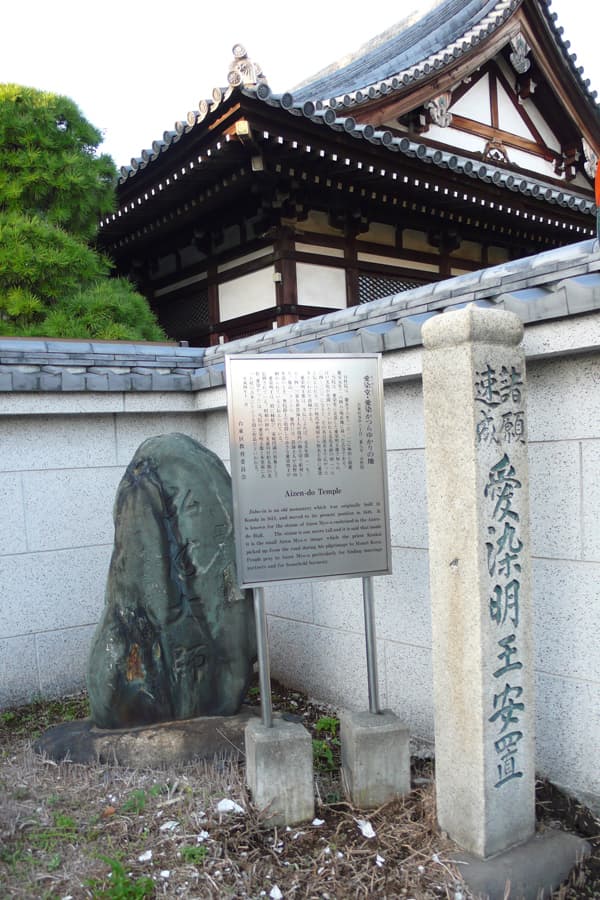
A row of cherry trees in Uenosakuragi

Old cherry tree in the Yanaka area, which is tinged with the evening glow.
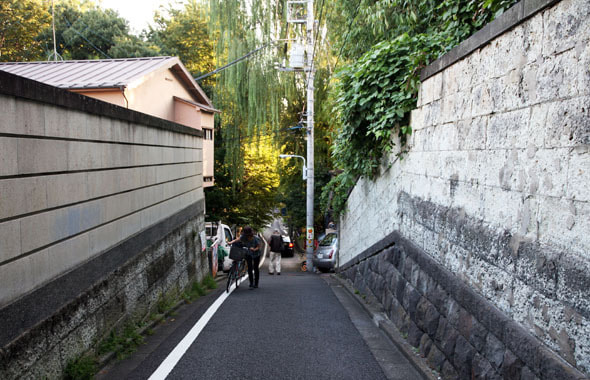
The Yanaka area has many slopes leading to the hill of Ueno.
The Uenosakuragi and Yanaka areas in northwest of Taito City are located at the east end of Yamate Plateau. The areas were the grounds of Toeizan Kan-eiji Temple that has housed the Tokugawa family's graves since the Edo Period. The former Uenosakuragi-cho was divided into a zone of Kan-eiji Temple and a northeast area (present-day Negishi 1-chome) of the hill of Ueno. The former was an area separated from Uenohanazono-cho, and the latter was a detached area of Yanaka Village. The town was named "Uenosakuragi-cho" because there were many cherry trees. There are many branch temples of Kan-eiji Temple in this area, and mausoleums of six shoguns and Yanaka Cemetery are located on the grounds of Kan-eiji Temple (Uenosakuragi) that has the Tokugawa family's plot. The area is a quiet temple town with many shade trees, including rows of cherry trees, as the place name suggests. Temples and scattered stores still have traces of the Edo, Meiji, Taisho and Showa Periods. Compared to an Edo Period atmosphere in Asakusa, Uenosakuragi and Yanaka recall the flavor of the Taisho and early Showa Periods, and remnants of so-called Taisho romanticism's modernism can be felt in those stores. There are many strollers who think of it with nostalgia and yearn for the old days while admiring rows of houses.
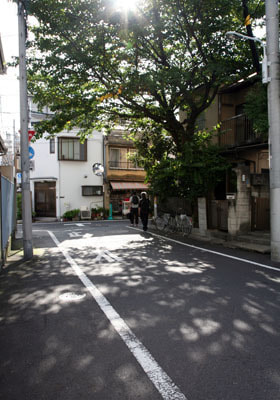
One of large cherry trees found all over the Yanaka area
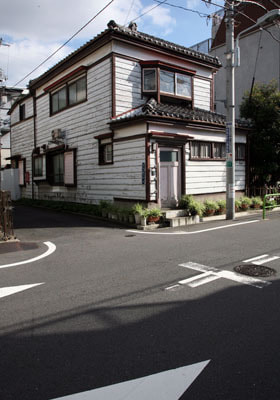
In Yanaka and Uenosakuragi, there are also many wooden houses that still retain some remnants of the good old days.
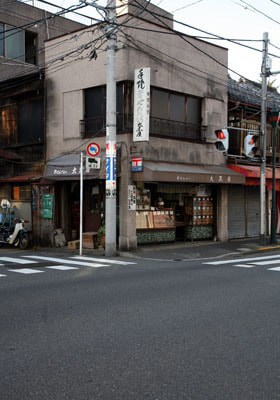
Long-established Japanese cracker store (Yanaka 1-chome)
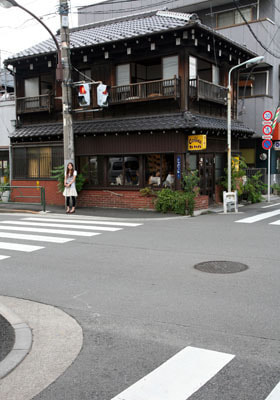
Renewed cafe that retains remnants of the Taisho and early Showa Periods (Yanaka 6-chome)
The Yanaka and Uenosakuragi areas are divided by Kototoi Street that runs form Nezu, Bunkyo Ward, to Negishi 1-chome and Asakura, and by the Sansaki slope that runs from Dango-sakashista, Sendagi, Bunkyo Ward to Uenosakuragi. In the neighborhood from this area to Bunkyo Ward, many writers and artists had lived since the Edo and Meiji Periods. They must had come and gone on this street.
In Yanaka 7-chome, there was a studio of Sculptor Fumio Asakura who graduated from Tokyo Fine Arts School (present-day Tokyo University of the Arts) and taught at the school. The studio is now preserved as the Asakura Choso Museum. Also, Sculptor Denchu Hiragushi studied under Tenshin Okakura, and built his studio (residence of Denchu Hiragushi) with the support of Taikan Yokoyama and others in Uenosakuragi. Hiragushi had lived in this area for a long time. He was called "Denchu Sensei," or Mr. Denchu, and popular among local people. Hiragushi respected Okakura, and it is said that he saluted the statue of Tenshi Okakura, created by Hiragushi himself, which is placed in Rokkakudo loacated in the center of Tokyo Fine Arts School (present-day Faculty of Fine Arts) when he went to the school. Okakura had lived in Yanaka 5-chome from 1898 to 1906, the year Okakura relocated his house to Itsuura, Ibaraki Prefecture, and established the "Nihon Bijutsuin" or the Japan Art Institute, in Yanaka. In 1966, Rokkakudo, in which the bust of Tenshin Okakura by Hiragushi is placed, was built at the site of Okakura's old house where the early Japan Art Institute was found, and the site was opened as Tenshin Okakura Memorial Park.
The site of Rohan Koda's old house, who was a great writer in the Meiji Period and wrote "Gojuno-to," or five-storied pagoda, is also located in Yanaka 7-chome. It is said that the novel "Gojuno-to" was modeled after a five-storied pagoda of Tennoji Temple in Yanaka, but it was burnt down in an arson attack in 1957, and its foundation stone is now preserved on the site. In Yanaka Cemetery, many writers, prominent figures and artists, including Fumio Asakura who settled in Yanaka, Taikan Yokoyama, Japanese-style painter Kiyokata Kaburaki, Kabuki actor Danzo Ichikawa VI, scholar Bin Ueda, novelist Bunroku Shishi, Fumiko Enchi, tanka poet Nobutsuna Sasaki, musician Michio Miyagi, sumo wrestler Tsuyoshi Kashiwado, and new school actor Otojiro Kawakami, are enshrined. Yanaka, Uenosakuragi, Sendagi and Nezu in Bunkyo Ward, and Ikenohata had been areas where many artists had lived, come and gone since the time of Tokyo Fine Arts School and Tokyo Music School.
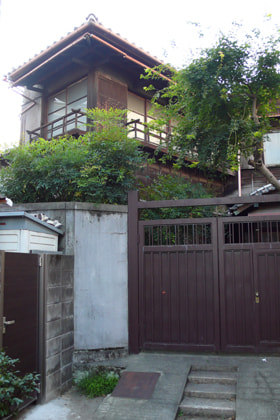
Former residence of Denchu Hiragushi
Although the Hiragushi's old house is now owned by Ibara City, Okayama Prefecture, which is his native place, and is not open to the public, it is used for exhibitions organized by Tokyo University of the Arts and for community exhibitions in order to promote art.
Aizendo, a place in connection with the novel "Aizen-katsura"
Jishoin Temple (Yanaka 6-chome) is an old temple which was founded in Kanda and later transferred to the present location. The temple has also been called "Aizen Temple" since around mid-Edo Period because it houses the statue of Aizen-myo-o. It is said that great writer Matsutaro Kawaguchi's masterpiece "Aizen-katsura" was written about the statue of Aizen-myo-o and an old katsura tree in front of the temple's main building. [Click the picture to enlarge. For more details of Aizendo, please refer to the section "Yanaka" in "tour, landscapes and cultural heritages. (The statue of Aizen-myo-o is not open to the public.)]"

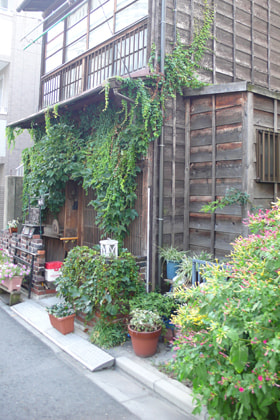
In front of houses in the Yanaka and Sakuragi areas, a variety of greenery is placed, putting on a beautiful display of color.
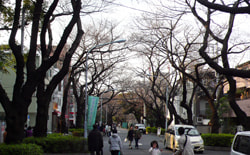
A row of cherry trees in Uenosakuragi
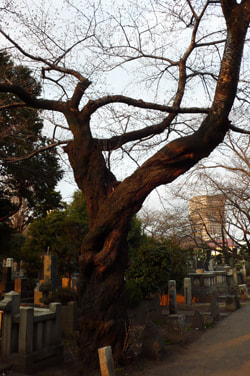
Old cherry tree in the Yanaka area, which is tinged with the evening glow.













